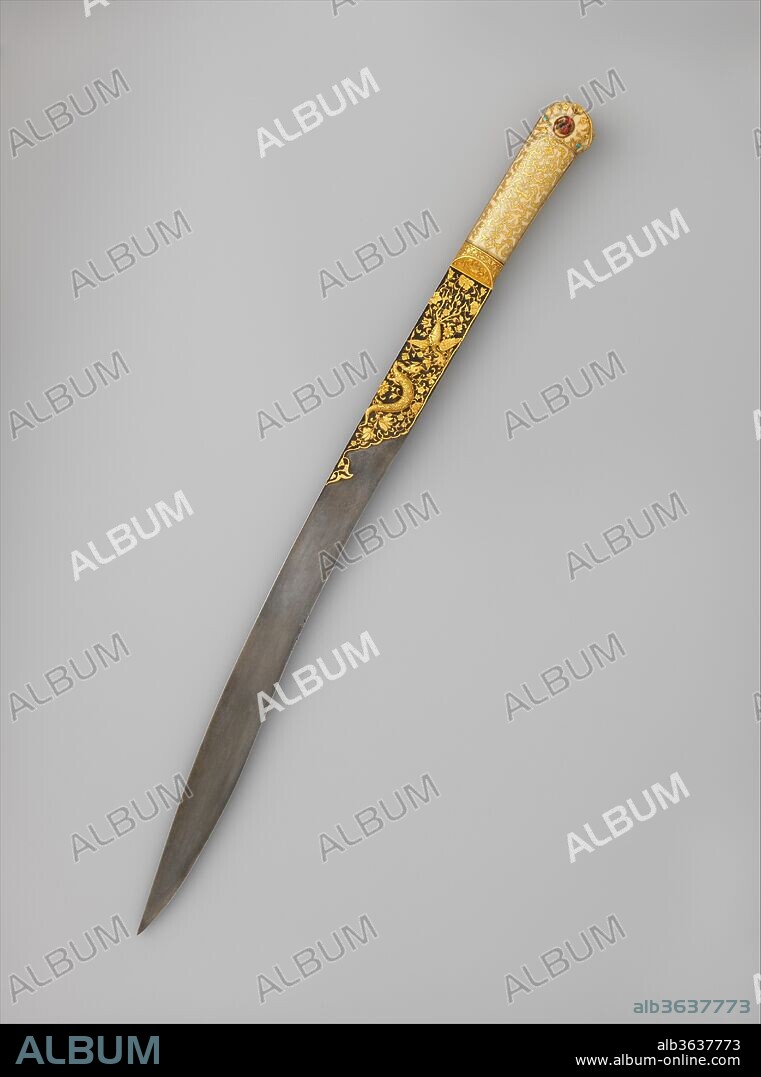alb3637773
Short Sword (Yatagan) from the Court of Süleyman the Magnificent (reigned 1520-66)

|
Zu einem anderen Lightbox hinzufügen |
|
Zu einem anderen Lightbox hinzufügen |



Haben Sie bereits ein Konto? Anmelden
Sie haben kein Konto? Registrieren
Dieses Bild kaufen.
Nutzung auswählen:

Titel:
Short Sword (Yatagan) from the Court of Süleyman the Magnificent (reigned 1520-66)
Untertitel:
Siehe automatische Übersetzung
Short Sword (Yatagan) from the Court of Süleyman the Magnificent (reigned 1520-66). Culture: Turkish, Istanbul. Dimensions: L. 23 3/8 in. (59.3 cm); L. of blade 18 3/8 in. (46.7 cm); Wt. 1 lb. 8 oz. (691 g). Sword maker: Workshop of Ahmed Tekelü (possibly Iranian, active Istanbul, ca. 1520-30). Date: ca. 1525-30.
Exquisite workmanship and lavish use of precious materials distinguish this sword as a princely weapon and exemplifies the opulence and refinement of Ottoman luxury arts. Almost identical to a yatagan (now in the Topkapi Palace, Istanbul) made in 1526-27 by the court jeweler Ahmed Tekel, for the Ottoman sultan Süleyman the Magnificent (r. 1520-66), this sword was undoubtedly made in the same imperial workshop. The gold incrustation on the blade depicts a combat between a dragon and a phoenix against a background of foliate scrolls. These figures, like the gold-inlaid cloud bands and foliate scrolls on the ivory grips, are Chinese in inspiration, and were probably introduced into Ottoman art through contacts with Persia.
This sword is one of the earliest known yatagans, distinctly Turkish weapons characterized by a double-curved blade and a hilt without a guard. Yatagans were commonplace in Turkey and the Balkans in the eighteenth and nineteenth centuries and served as sidearms for the elite troops known as janissaries.
Technik/Material:
Steel, gold, ivory (walrus), silver, turquoise, pearls, rubies
Museum:
Metropolitan Museum of Art, New York, USA
Bildnachweis:
Album / Metropolitan Museum of Art, NY
Freigaben (Releases):
Model: Nein - Eigentum: Nein
Rechtefragen?
Rechtefragen?
Bildgröße:
3170 x 4265 px | 38.7 MB
Druckgröße:
26.8 x 36.1 cm | 10.6 x 14.2 in (300 dpi)
Schlüsselwörter:
 Pinterest
Pinterest Twitter
Twitter Facebook
Facebook Link kopieren
Link kopieren Email
Email
